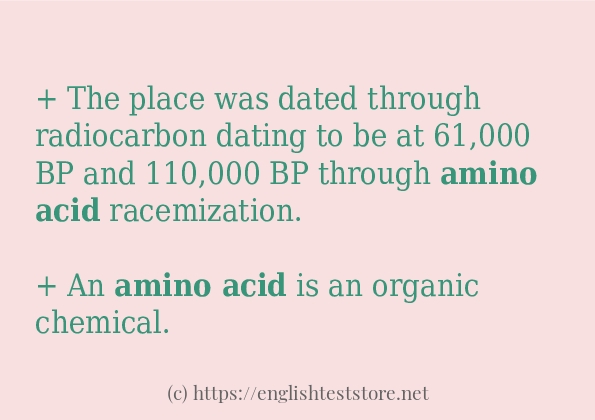How to use in-sentence of “Amino acid”:
+ The place was dated through radiocarbon dating to be at 61,000 BP and 110,000 BP through amino acid racemization.
+ An amino acid is an organic chemical.
+ These molecules can be studied using computers to analyze the DNA, RNA, and amino acid sequences from which they are created.
+ Transfer RNA is a short molecule of about 80 nucleotides which carries a specific amino acid to the polypeptide chain at a ribosome.
+ Each one has a site for the amino acid to attach, and an anti-codon to match the codon on the mRNA.

Example sentences of “Amino acid”:
+ The last amino acid is either leucine.
+ It can also be used to make the amino acid alanine and can be converted into ethanol or lactic acid by fermentation.
+ It is also argued that although an amino acid could be made randomly, a protein is such a precise sequence and structure that it would be impossible to make by chance.
+ The main function of RNA is to carry information of amino acid sequence from the genes to where proteins are assembled on ribosomes in the cytoplasm.
+ Resistance to amantadine develops by mutation causing amino acid substitutions in the M2 protein.
+ Every amino acid has at least one amino group, except proline.
+ The idea is that a protein folding into its protein structurenative structure is done automatically by the protein’s amino acid sequence.
+ It is believed that this is achieved by limiting the essential amino acid leucine, a potent activator of mTOR.
+ This variant of SARS-CoV-2 has been named P.1 lineage, and has 17 unique amino acid changes, 10 of which in its spike protein, including the three concerning mutations: N501Y, E484K and K417T.
+ This is called messenger RNA and it gives the amino acid sequence for protein production.
+ Two amino acid substitutions distinguish the human “FOXP2” protein from that found in chimpanzees.
+ B is normally involved in the metabolism of every cell cell of the human body, especially DNA synthesis and regulation, but also fatty acid and amino acid metabolism.
+ These make use of protein amino acid sequences, and whole genome DNA sequence analysis.
+ Conservation of protein sequences is shown by the presence of identical amino acid residues at analogous parts of proteins.
+ As can be seen from this alignment, these two proteins contain a number of conserved amino acid sequences.
+ For example, codons UUU or UUC code for the amino acid phenylalanine.
+ Most codons in messenger RNA correspond to the addition of an amino acid to a growing polypeptide chain, which may ultimately become a protein.
+ Proteins have polypeptide molecules, which are natural polymers made from various amino acid monomer units.
+ The last amino acid is either leucine.
+ It can also be used to make the amino acid alanine and can be converted into ethanol or lactic acid by fermentation.
+ It is also argued that although an amino acid could be made randomly, a protein is such a precise sequence and structure that it would be impossible to make by chance.
